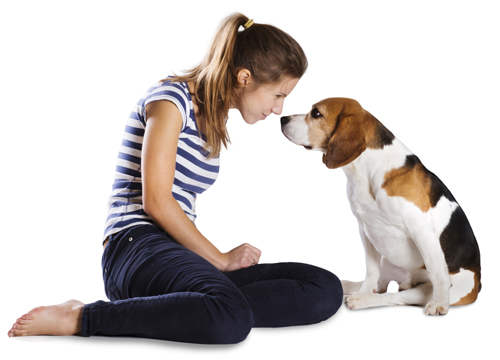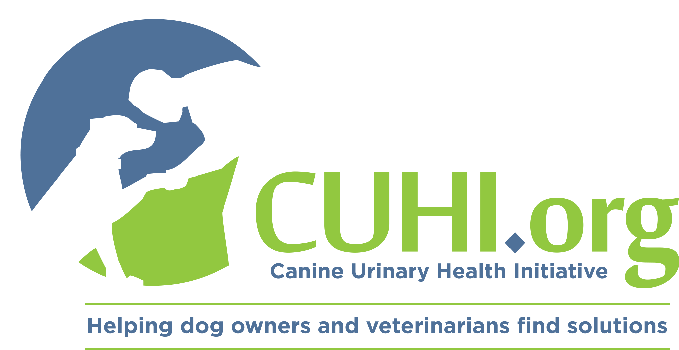Urethral Sphincter Control:
Leaky Dog? Urinary Incontinence in Dogs
By Dr. Susan Nelson
Associate Professor at the Veterinary Health Center at Kansas State University
Are you starting to find puddles of urine in the house? Are there wet spots where your dog has been lying or sitting? Does your dog have wet hair between her back legs or smell like urine? If the answer is “yes” to any of these, your dog may be experiencing a condition called urinary incontinence.
Many people assume a “leaky dog” is due to aging and there are no treatment options. They don’t seek help for their pet, or worse, they have it euthanized. The reality is this condition can often be easily managed.
What is Urinary Incontinence?
Urinary incontinence is the loss of your dog’s ability to control urination. The most common reason for this condition in dogs is acquiring it as they mature. This condition goes by several names. Technical names are “urethral sphincter hypotonus”, “primary sphincter mechanism incompetence (PSMI)”, “idiopathic incontinence,” and “hormone-responsive incontinence”. The less technical name is “weak bladder”.
Regardless of what it’s called, the sphincter muscle in the urethra (the tube that leads from the bladder to the outside) has become weak and is less effective at holding back the urine. This condition primarily affects middle-aged to older, spayed female dogs. Approximately 1 out of 5 female dogs will be affected by this condition after they are spayed (removal of the ovaries +/- uterus¹). It can also affect younger, spayed females, intact females and intact or neutered males, but to a much lesser extent. Does this mean you should not have your female dog spayed? NO! There are far too many health benefits from being spayed.
How it Happens
Dogs with a weak bladder can hold their urine while awake but often “leak” when they are relaxed or asleep. Owners will often find spots of urine around the house; typically where the dog had been lying or sitting. The spots can range in size. Dogs often start with occasionally leaking small amounts of urine. These episodes gradually increase in amounts and frequency as time goes by. Owners may also notice their dog licking their penis or vulva more frequently. Skin around the genitalia may be red and irritated; and the hair may be damp and smelly. During the summer months, the irritated areas of skin may become infested with maggots.
Other Reasons for Urinary Incontinence
If your dog is leaking urine, it is very important to schedule a visit with your veterinarian in order to rule out other causes of incontinence. You can’t just assume it is a weak bladder. Other conditions that can cause urinary incontinence are urinary tract infection, bladder stones, injuries or degenerative diseases of the back, prostate problems, birth defects, diseases that cause excessive drinking such as diabetes, senility, submissive urination and the lack of house training. Most of these conditions require a different form of treatment than that for urethral sphincter hypotonus. Many of these other conditions can be ruled in or out by a simple urinalysis and urine culture. Your veterinarian may also order additional tests if necessary to help provide a correct diagnosis.
Treatment Options
So now you’ve taken your dog to your veterinarian and have received the diagnosis of urethral sphincter hypotonus. What can be done about it? There are options for dealing with or treating this problem. They include:
- Prescription drugs that affect the sphincter muscle and help to tone it
- Surgery to correct an ectopic ureter (when the tubes that propel urine from the kidneys to the urinary bladder end in the wrong spot within the body)
- Collagen injections into the urethra
Of these options, drugs are the first choice for treatment, with surgery and injections reserved for those dogs who have not responded well to their medications.
Medication Options
Two medications are most commonly used to treat urinary incontinence. They are:
- Diethylstilbestrol (DES), an estrogen, is given once to several times a week. Some dogs cannot tolerate it as they will begin to show signs of being in heat while they are taking the drug. There is also the possibility of bone marrow toxicity if the dose is not monitored carefully. It is important that blood work be checked periodically when using this drug. This drug is only available through compounding pharmacies and is not an FDA-approved treatment.
- Phenylpropanolamine hydrochloride (PPA) is considered the drug of choice for the treatment of urinary incontinence due to urethral sphincter hypotonus. Up until recently, one could only get PPA through compounding pharmacies. Now there is PROIN®. PROIN® is the only FDA-approved PPA product available to treat urinary incontinence in dogs due to urethral sphincter hypotonus. It comes in a liver-flavored, chewable tablet that is available in 3 strengths. It contains no beef or beef by-products, which is good for food-allergic dogs. Dogs also like the taste, with the majority of dogs willing to eat the pill by itself or when placed in their food. The pills are easily given once in the morning and once at night. It is important to recognize that effects of PPA are not immediate and that it may take several days before the full effects of PROIN® are seen and you notice an improvement in your dog’s incontinence. PROIN®must be given every day for continued effect. In the 180 day field study to test effectiveness, PROIN® was well-tolerated by dogs and over 90% of dog owners were satisfied with the results.
As with any long-term medication, lab work should be performed before starting any drug protocol. Blood pressure, blood work and urine samples should be monitored periodically to ensure your dog can continue to take the medication. The most common side effects are vomiting, increase in blood pressure, decrease in appetite, weight loss, protein in the urine and behavioral changes. The majority of dogs can take PROIN® with no problems; however, you should speak to your veterinarian about any pre-existing health problems that may keep PPA from being a good option.
 No Need for a Plumber
No Need for a Plumber
Urinary incontinence due to urethral sphincter hypotonus is a common condition with affordable and effective options for treatment. It is not hopeless. Speak to your veterinarian about your dog’s condition and the best treatment option that works for your pet.
Important Drug Information: PROIN® may cause increased thirst; therefore provide ample fresh water. Use in dogs with incontinence due to a urinary tract infection will mask symptoms. PROIN® is not effective in dogs with incontinence due to neurologic disease or malformation. PROIN® may cause hypertension; therefore use with caution in dogs with pre-existing heart disease, hypertension, liver disease, kidney insufficiency, diabetes, glaucoma, and conditions with a predilection for hypertension. Use with caution in dogs receiving sympathomimetic drugs, tricyclic antidepressants, or monoamine oxidase inhibitors as increased toxicity may result. Use with caution in dogs administered halogenated gaseous anesthetics as this may increase the risk of cardiac arrhythmias. The most commonly reported side effects were: emesis, hypertension, anorexia, weight loss, proteinuria, and behavioral changes. Please refer to full package label for complete product information.
¹ JAVMA Vol 239 No 11. December 1, 2011 pages 1409-1412
Susan Nelson, DVM, is an Associate Professor in the Department of Clinical Sciences at the Veterinary Health Center at Kansas State University. Dr. Nelson received her BA in Biology in 1985 from Hastings College in Hastings, NE. She then completed her DVM at Kansas State University in 1989. After receiving her DVM, Dr. Nelson spent her next 14 years as an associate veterinarian in a companion animal practice in Manhattan, KS. In 2003, Dr. Nelson joined the faculty at the Veterinary Health Center at Kansas State University. She is currently a clinical instructor for senior veterinary students in the hospital’s Pet Health Center, where students are taught the necessary skills needed to meet the challenges of being a primary care veterinarian. She also works in conjunction with the hospital’s mental health therapist in the instruction of communication skills. Her interests are in wellness and preventative medicine. Dr. Nelson is also a board member for the Kansas State Animal Response Team (KSSART), an organization that is active in the development of animal disaster response for the state of Kansas.
Proin® is a registered trademark of Pegasus Laboratories, Inc.
This article is copyright protected property of Pegasus Laboratories, Inc. and the content may not be altered. Clients are required to use the following copyright notice underneath the article when published. © 2012 Pegasus Laboratories, Inc. All rights reserved
